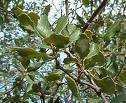Dwarf Interior Live Oak Tree Information
Images of Dwarf Interior Live Oak:






Dwarf Interior Live Oak grows in the following 3 states and provinces:
California, Colorado, MaineInformation about Dwarf Interior Live Oak:
The Quercus Wislizenii is commonly known as the Dwarf Interior Live Oak, Highland Live Oak, Interior Live Oak, Scrub Interior Live Oak as well as Sierra Live Oak.
The currently accepted scientific name of interior live oak is Quercus wislizenii A. DC . Interior live oak is a member of the black or red oak subgenus Erythrobalanus . It readily hybridizes with other sympatric oaks including California black oak (Q. kellogii) and California live oak (Q. agrifolia) . The oracle oak (Q. x morehus) is believed to be a product of interior live oak and California black oak hybridization . Interior live oak is described as morphologically "diverse," and a number of recognizable varieties or forms have been reported . These taxa differ in such characteristics as leaf and acorn morphology, and general growth habit. Currently recognized varieties are as follows : Quercus wislizenii var. frutescens Engelm. Quercus wislizenii var. wislizenii Quercus wislizenii forma extima Jeps.Interior live oak occurs from Siskiyou and Shasta counties of northern California south along the foothills of the Sierra Nevada and inner Coast Ranges into northern Mexico . It is common near the coast and on the Channel islands . Interior live oak grows on approximately 884,000 acres (357,895 ha) in California . The variety frutescens occurs throughout the mountains of southern California northward to Lake and Shasta counties. However, this variety is uncommon in the Sierra Nevada .This oak sometimes occurs in dense groves of small, evenly spaced individuals but also forms shrubby thickets within mixed-conifer forests . It occurs below the mixed conifer zone in northern oak woodlands with such species as Oregon white oak (Quercus garryana), blue oak (Q. douglasii), valley oak (Q. lobata), canyon live oak (Q. chrysolepis), and gray pine (P. sabiniana) . Interior live oak is an important component of certain riparian woodlands of California . Interior live oak is well-represented in oak chaparral or montane chaparral dominated by such species as Nuttall's scrub oak (Q. dumosa) . It also occurs in pinyon (Pinus spp.) woodlands and in humid conifer forests of the central California coast . The variety frutescens is most closely associated with fairly xeric chaparral communities of southern California . Interior live oak has been included in the following plant associations and community types: Vegetation types of the San Gabriel Mountains Vegetation of the San Bernadino Mountains A vegetation classification system applied to souther California The vascular plant communities of California An introduction to the plant communities of the Santa Ana and San Jacinto Mountains Associated species: Other conifer or hardwood associates of interior live oak include coastal live oak (Quercus agrifolia), Douglas-fir (Pseudotsuga menziesii), Jeffrey pine (Pinus jeffreyi), redwood (Sequoia sempervirens), ponderosa pine (Pinus ponderosa), cottonwoods (Populus spp.), tanoak (Lithocarpus densiflorus), and Pacific madrone (Arbutus menziesii) . Commonly associated understory species include manzanita (Arctostaphylos spp.), ceanothus (Ceanothus spp.), birchleaf mountain-mahogany (Cercocarpus betuloides), hazel (Corylus cornuta), two-petal ash (Fraxinus dipetala), toyon (Heteromeles arbutifolia), yerba santa (Eriodycton californicum), redberry (Rhamnus crocea), chamise (Adenostoma fasciculatum), poison-oak (Toxicodendron diversiloba), California redbud (Cercis occidentalis), sagebrush (Artemisia spp.), and rabbitbrush (Chrysothamnus spp.) . Serviceberry (Amelanchier spp.), snowberry (Symphoricarpos spp.), raspberries (Rubus spp.), and oceanspray (Holodiscus discolor) are common plant associates in timbered areas .Some of the information provided here is attributed to:Tirmenstein, D. 1989. Quercus wislizenii. In: Fire Effects Information System, [Online]. U.S. Department of Agriculture, Forest Service, Rocky Mountain Research Station, Fire Sciences Laboratory (Producer). , available at the USDA Fire Effects Information System (FEIS) website